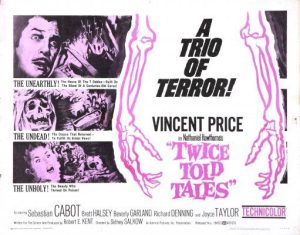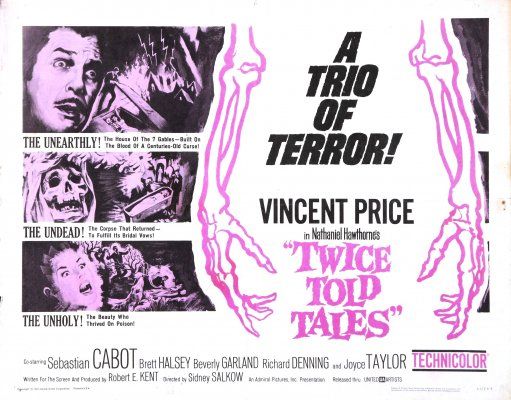
This is a compilation of three short films based on Nathaniel Hawthorne works–Heidegger’s Experiment, Rappaccini’s Daughter and The House of Seven Gables. All feature Vincent Price in a lead role. In Heidegger’s Experiment, Dr. Carl Heidegger (Sebastian Cabot), obsessed with his deceased fiancée for 38 years, discovers a possible fountain of youth. But will restored youth bring happiness? In Rappaccini’s Daughter, Professor Rappaccini (Price) discovers a “treatment” that will prevent his daughter from committing or being subjected to the same evils as his wife. And in The House of Seven Gables, a 150-year-old injustice leads to a unshakable curse.
First, a “warning” of sorts to potential viewers who are not acclimated to films of bygone eras. When compared to modern horror such as Saw (2004), Twice-Told Tales is relatively slow, talky, stagy, and uneventful. It may even be relatively slow, talky, stagy and uneventful compared to many films of its era. That doesn’t mean it isn’t a good film. But if you’re not acclimated to the style, it takes some getting used to.
It’s definitely worth getting used to, because these three short films by director Sidney Salkow are atmospheric, captivating stories, full of horror if you are able to slow yourself down and be absorbed by them. The film’s fine technical elements–the sets, costumes, cinematography, lighting, music and so on–help draw one in to the proceedings.
As with most Hawthorne, the stories have strong moral subtexts, often hinging on just deserts for questionable ethical decisions, which are often themselves made with an aim of protecting ethical “purity” in some way. Or in other words, a few bad decisions combined with trying to do the “right thing” often leads to horrifying situations due to a kind of karmic retribution–basically kicking oneself in the bum. There are occasionally innocent parties–such as Rappaccini’s daughter, but they tend to be few and far between. Speaking of Rappaccini’s Daughter, it’s interesting to note that this could easily count as an early sci-fi tale from Hawthorne.
For horror fans, the most important aspect of the film is that Twice-Told Tales’ scenarios are macabre and frequently terrifying. Although you certainly shouldn’t expect gore in a film like this, there are a few skeletons, crispy critters and a surprising amount of blood in one segment. But gore in itself doesn’t necessarily produce the feeling of being horrified, which is more a sinking feeling in the pit of one’s stomach at the realization that everything has suddenly gone to hell. Although I agree that gore wouldn’t hurt (I’m a big Fangoria fan, too), what creates the horrific in Twice-Told Tales are the impeccably established characters and relationships followed by tragic changes in their relationships. Salkow and the cast slowly but flawlessly build tension in this way, and all of the segments have wonderfully nihilistic endings. Only the House of Seven Gables offers a slight glimpse of hope at the end.
Twice-Told Tales isn’t the first compilation film or even the first horror compilation film, but it is one of the earlier, better and influential examples. Salkow’s impact on horror wasn’t to end here, as he went on to co-direct the excellent Price vehicle The Last Man on Earth in 1964, which was a big influence on subsequent films such as 28 Days Later (2002). He also directed a few episodes of “The Addams Family”, before finishing out his career with a few westerns.

